So where are we on this April Sunday morning?
As a farming community, the answer is: still standing. Importantly, we are standing together. The weather was shocking in places in recent days, with teeming rain leaving fields completely sodden yet again.
Against that, there have been lorries of imported fodder being unloaded, with more to follow in every region as all co-ops become involved.
Those imports will be subsidised in a simplified and nationwide fodder scheme which Minister Creed has pledged will remain open until June if necessary. He is now firmly, if belatedly, on the pitch.
The fodder crisis has become a dominant issue on mainstream news programmes since Thursday. It feels like recognition of the scale of the crisis has in itself helped farmers struggling to cope.
Being recognised as in need of support beats feeling invisible, that’s for sure. Guilt piled on top of stress and worry has stretched farmers to the limits of their resilience, and it’s only the support of family and fellow farmers that has kept people on some sort of even keel.
Of course, farmers have been helping each other for months now.
The “buddy-up” initiative that the IFA put in place saw farmers in the northwest receiving hay, silage and straw from those areas that then had surplus. Loads went from here in Wexford to Leitrim, where first cut silage wasn’t made in places until Ploughing week.
That solidarity was important for morale for the most beleaguered farmers in the northwest, where stock was housed while the kids were on their summer holidays.

Fodder imported by Dairygold lands in Rosslare, Co Wexford, on Thursday morning. \ Mary BrownFodder imported by Dairygold lands in Rosslare, Co Wexford, on Thursday morning. \ Mary Browne
The same meitheal spirit has been seen all over the country in recent weeks as, one by one, farmers run out of feed. It’s been the story of the spring and shows there is still heart – in both senses of the word – fight and empathy, left among farmers.
Leitrim was the epicentre of the early feed shortages. It’s been obvious since Halloween that 2017 would leave farmers struggling to cope with the winter across the west.
The Irish Farmers Journal’s front page that week had the headline “It has been a vicious year. It’s going to be a famine”.
It wasn’t being sensationalist. It was a stark warning from a contractor in Cavan, based on a lifetime of experience.
Why wasn’t that regional shortage more vigorously addressed?
Finance was in short supply on farms as much as feed. Drystock farmers, short of fodder due to a wretched summer, just hadn’t the reserves to buy more than they felt they needed to get through.
Many tried to cope month-by-month, hoping for an early turnout in the east, which would have seen feed flow in. It never happened.
The hope now is that the spring is finally on the way. The forecast, both in terms of temperatures and dry days, seems to be more optimistic for the week ahead.

Dairy farmers Paul Clarke, James Clarke with Mark Delahunty, General Manager, Lakeland Agri, and dairy farmer, Gerard Reilly, receiving a delivery of fodder from Lakeland Dairies, near Virginia, Co. Cavan.Dairy farmers Paul Clarke and James Clarke with Mark Delahunty, general manager, Lakeland Agri, and dairy farmer, Gerard Reilly, receiving a delivery of fodder from Lakeland Dairies, near Virginia, Co Cavan.
There will inevitably be a delayed reaction and turnout in those parts of the country where land is slowest to dry, but if sheds are emptied in some regions, fodder can flow into the remaining areas of need.
What follows is twofold.
This winter has imposed hardship on farms, that has been endured, but the extra costs must still be borne and paid back over time. The banks need to show understanding and work with their farmer clients to allow them get back on their feet gradually.
Minister Creed should strive to ensure that a large chunk of the low-interest loan fund is ring-fenced for farmers who need a financial bridge back to level ground.
Secondly, there has to be an overall review to ensure we are in a position to cope with the next long winter, be it in 20 years or 12 months. Every farmer will want to have a buffer on hand.
It would be optimistic to think that grass crops alone can achieve this. We need a plan, and the tillage sector can play a key part. Hardly an acre has been sown this spring, and it’s nearly too late for beans and wheat.
Why not have an initiative where maize, beet, arable silage, and westerworlds are grown on contract to fill the gap? It would simultaneously solve the three-crop rule bind tillage farmers find themselves in.
Some funding for this would make it affordable, and ensure that we properly address the root cause of the fodder shortages – a lack of buffer stocks.
It’s not a fix-all, but it’s a starting point. Meanwhile, everybody hang on, and hang together.
Read more
Listen: 'Adjusting is not a failure' – mental health tips for the fodder crisis
'It’s the men and women I’m worried about - we’ll get fodder for cattle'
Over 500 farmers in need of fodder contact Teagasc
Bishop calls for prayers for the farming community in midst of fodder crisis
Emergency fodder trickles down to farms
So where are we on this April Sunday morning?
As a farming community, the answer is: still standing. Importantly, we are standing together. The weather was shocking in places in recent days, with teeming rain leaving fields completely sodden yet again.
Against that, there have been lorries of imported fodder being unloaded, with more to follow in every region as all co-ops become involved.
Those imports will be subsidised in a simplified and nationwide fodder scheme which Minister Creed has pledged will remain open until June if necessary. He is now firmly, if belatedly, on the pitch.
The fodder crisis has become a dominant issue on mainstream news programmes since Thursday. It feels like recognition of the scale of the crisis has in itself helped farmers struggling to cope.
Being recognised as in need of support beats feeling invisible, that’s for sure. Guilt piled on top of stress and worry has stretched farmers to the limits of their resilience, and it’s only the support of family and fellow farmers that has kept people on some sort of even keel.
Of course, farmers have been helping each other for months now.
The “buddy-up” initiative that the IFA put in place saw farmers in the northwest receiving hay, silage and straw from those areas that then had surplus. Loads went from here in Wexford to Leitrim, where first cut silage wasn’t made in places until Ploughing week.
That solidarity was important for morale for the most beleaguered farmers in the northwest, where stock was housed while the kids were on their summer holidays.

Fodder imported by Dairygold lands in Rosslare, Co Wexford, on Thursday morning. \ Mary BrownFodder imported by Dairygold lands in Rosslare, Co Wexford, on Thursday morning. \ Mary Browne
The same meitheal spirit has been seen all over the country in recent weeks as, one by one, farmers run out of feed. It’s been the story of the spring and shows there is still heart – in both senses of the word – fight and empathy, left among farmers.
Leitrim was the epicentre of the early feed shortages. It’s been obvious since Halloween that 2017 would leave farmers struggling to cope with the winter across the west.
The Irish Farmers Journal’s front page that week had the headline “It has been a vicious year. It’s going to be a famine”.
It wasn’t being sensationalist. It was a stark warning from a contractor in Cavan, based on a lifetime of experience.
Why wasn’t that regional shortage more vigorously addressed?
Finance was in short supply on farms as much as feed. Drystock farmers, short of fodder due to a wretched summer, just hadn’t the reserves to buy more than they felt they needed to get through.
Many tried to cope month-by-month, hoping for an early turnout in the east, which would have seen feed flow in. It never happened.
The hope now is that the spring is finally on the way. The forecast, both in terms of temperatures and dry days, seems to be more optimistic for the week ahead.

Dairy farmers Paul Clarke, James Clarke with Mark Delahunty, General Manager, Lakeland Agri, and dairy farmer, Gerard Reilly, receiving a delivery of fodder from Lakeland Dairies, near Virginia, Co. Cavan.Dairy farmers Paul Clarke and James Clarke with Mark Delahunty, general manager, Lakeland Agri, and dairy farmer, Gerard Reilly, receiving a delivery of fodder from Lakeland Dairies, near Virginia, Co Cavan.
There will inevitably be a delayed reaction and turnout in those parts of the country where land is slowest to dry, but if sheds are emptied in some regions, fodder can flow into the remaining areas of need.
What follows is twofold.
This winter has imposed hardship on farms, that has been endured, but the extra costs must still be borne and paid back over time. The banks need to show understanding and work with their farmer clients to allow them get back on their feet gradually.
Minister Creed should strive to ensure that a large chunk of the low-interest loan fund is ring-fenced for farmers who need a financial bridge back to level ground.
Secondly, there has to be an overall review to ensure we are in a position to cope with the next long winter, be it in 20 years or 12 months. Every farmer will want to have a buffer on hand.
It would be optimistic to think that grass crops alone can achieve this. We need a plan, and the tillage sector can play a key part. Hardly an acre has been sown this spring, and it’s nearly too late for beans and wheat.
Why not have an initiative where maize, beet, arable silage, and westerworlds are grown on contract to fill the gap? It would simultaneously solve the three-crop rule bind tillage farmers find themselves in.
Some funding for this would make it affordable, and ensure that we properly address the root cause of the fodder shortages – a lack of buffer stocks.
It’s not a fix-all, but it’s a starting point. Meanwhile, everybody hang on, and hang together.
Read more
Listen: 'Adjusting is not a failure' – mental health tips for the fodder crisis
'It’s the men and women I’m worried about - we’ll get fodder for cattle'
Over 500 farmers in need of fodder contact Teagasc
Bishop calls for prayers for the farming community in midst of fodder crisis
Emergency fodder trickles down to farms








 This is a subscriber-only article
This is a subscriber-only article










SHARING OPTIONS: